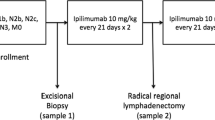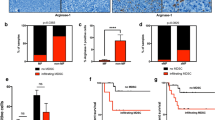Abstract
Background
Immune markers in the peripheral blood of melanoma patients provide useful information for clinical management although there is poor consensus on circulating cells which could putatively reflect the disease activity and play a prognostic role. Here, we investigated both dendritic cells (DCs) and T-regulatory cells (Tregs).
Methods
The number of DC subsets as myeloid (m) and plasmacytoid was measured by flowcytometry in 113 melanoma patients in different clinical stages and correlated with the disease activity to evaluate the recurrence free survival (RFS) calculated as difference between baseline and post-surgical values in relation to the criteria for the melanoma staging, as primary tumor removal, sentinel lymph node biopsy and completion of lymph node dissection.
Results
Circulating mDC levels were significantly lower in metastatic melanoma than in other stages and inversely correlated to Treg values while both populations were similarly expressed in inactive disease at stage I-III. Furthermore, the levels of these cells after melanoma removal were apparently related to the disease activity since their persistent defect reflected high risk of recurrence and reduced the RFS.
Conclusions
This work highlighted the role of immune cell measurement for the management of melanoma activity and the identification of patients at potential risk of recurrence based on the mDC ratio.





Similar content being viewed by others
References
Stiegel E, Xiong D, Ya J, Funchain P, Isakov R, Gastman B, et al. Prognostic value of sentinel lymph node biopsy according to Breslow thickness for cutaneous melanoma. J Am Acad Dermatol. 2018;78:942–8.
Gershenwald JE, Scolyer RA. Melanoma staging: American Joint Committee on Cancer (AJCC) 8th Edition and Beyond. Ann Surg Oncol. 2018;25:2105–10 (Springer International Publishing).
Pasquali S, Mocellin S, Mozzillo N, Maurichi A, Quaglino P, Borgognoni L, et al. Nonsentinel lymph node status in patients with cutaneous melanoma: results from a multi-institution prognostic study. J Clin Oncol. 2014;32:935–41.
Leiter U, Stadler R, Mauch C, Hohenberger W, Brockmeyer N, Berking C, et al. Complete lymph node dissection versus no dissection in patients with sentinel lymph node biopsy positive melanoma (DeCOG-SLT): a multicentre, randomised, phase 3 trial. Lancet Oncol. 2016;17:757–67.
Tucci M, Stucci S, Passarelli A, Giudice G, Dammacco F, Silvestris F. The immune escape in melanoma: role of the impaired dendritic cell function. Expert Rev Clin Immunol. 2014;10:000 (Informa UK, Ltd).
Chevolet I, Speeckaert R, Schreuer M, Neyns B, Krysko O, Bachert C, et al. Characterization of the in vivo immune network of IDO, tryptophan metabolism, PD-L1, and CTLA-4 in circulating immune cells in melanoma. OncoImmunology. 2015;4:e982382 (Taylor & Francis).
Damude S, Wevers KP, Murali R, Kruijff S, Hoekstra HJ, Bastiaannet E. A prediction tool incorporating the biomarker S-100B for patient selection for completion lymph node dissection in stage III melanoma. Eur J Surg Oncol. 2017;43:1753–9.
Damude S, Hoekstra HJ, Bastiaannet E, Muller Kobold AC, Kruijff S, Wevers KP. The predictive power of serum S-100B for non-sentinel node positivity in melanoma patients. Eur J Surg Oncol. 2016;42:545–51.
Weber J, Qureshi A, Ascierto PA. Adjuvant Therapy in Resected Melanoma. N Engl J Med. 2018;378:680 (Massachusetts Medical Society).
Galon J, Lugli A, Bifulco C, Pages F, Masucci G, Marincola FM, et al. World-wide immunoscore task force: meeting report from the “Melanoma Bridge”, Napoli, November 30th-December 3rd, 2016. J Transl Med. 2017;15:212. https://doi.org/10.1186/s12967-017-1310-9.
Failli A, Legitimo A, Orsini G, Romanini A, Consolini R. Numerical defect of circulating dendritic cell subsets and defective dendritic cell generation from monocytes of patients with advanced melanoma. Cancer Lett. 2013;337:184–92 (Elsevier Ireland Ltd).
McCarter MD, Baumgartner J, Escobar GA, Richter D, Lewis K, Robinson W, et al. Immunosuppressive dendritic and regulatory T cells are upregulated in melanoma patients. Ann Surg Oncol. 2007;14:2854–60 (Springer-Verlag).
Houot R, Perrot I, Garcia E, Durand I, Lebecque S. Human CD4 + CD25 high regulatory T cells modulate myeloid but not plasmacytoid dendritic cells activation. J Immunol Am Assoc Immunol. 2006;176:5293–8.
Gerlini G, Tun-Kyi A, Dudli C, Burg G, Pimpinelli N, Nestle FO. Metastatic melanoma secreted IL-10 down-regulates CD1 molecules on dendritic cells in metastatic tumor lesions. Am J Pathol. 2004;165:1853–63.
Roberts EW, Broz ML, Binnewies M, Headley MB, Nelson AE, Wolf DM, et al. Critical role for CD103(+)/CD141(+) dendritic cells bearing CCR7 for tumor antigen trafficking and priming of T cell immunity in melanoma. Cancer Cell. 2016;30:324–36.
Chevolet I, Speeckaert R, Schreuer M, Neyns B, Krysko O, Bachert C, et al. Clinical significance of plasmacytoid dendritic cells and myeloid-derived suppressor cells in melanoma. J Transl Med. 2015;13:9.
Legitimo A, Consolini R, Failli A, Orsini G, Spisni R. Dendritic cell defects in the colorectal cancer. Hum Vaccin Immunother. 2014;10:3224–35.
Verronèse E, Delgado A, Valladeau-Guilemond J, Garin G, Guillemaut S, Tredan O, et al. Immune cell dysfunctions in breast cancer patients detected through whole blood multi-parametric flow cytometry assay. OncoImmunology. 2016;5:1–15 (Taylor & Francis).
Patin E, Hasan M, Bergstedt J, Rouilly V, Libri V, Urrutia A, et al. Publisher Correction: natural variation in the parameters of innate immune cells is preferentially driven by genetic factors. Nat Immunol. 2018;19:645–55 (Nature Publishing Group).
Mannavola F, Tucci M, Felici C, Stucci S, Silvestris F. miRNAs in melanoma: a defined role in tumor progression and metastasis. Expert Rev Clin Immunol. 2015;12:79–89.
Lombardi VC, Khaiboullina SF, Rizvanov AA. Plasmacytoid dendritic cells, a role in neoplastic prevention and progression. Eur J Clin Invest. 2014;45:1–8.
Gerlini G, Urso C, Mariotti G, Di Gennaro P, Palli D, Brandani P, et al. Plasmacytoid dendritic cells represent a major dendritic cell subset in sentinel lymph nodes of melanoma patients and accumulate in metastatic nodes. Clin Immunol. 2007;125:184–93.
Orsini G, Legitimo A, Failli A, Ferrari P, Nicolini A, Spisni R, et al. Defective generation and maturation of dendritic cells from monocytes in colorectal cancer patients during the course of disease. IJMS. 2013;14:22022–41.
Bekeredjian-Ding I, Schäfer M, Hartmann E, Pries R, Parcina M, Schneider P, et al. Tumour-derived prostaglandin E and transforming growth factor-beta synergize to inhibit plasmacytoid dendritic cell-derived interferon-alpha. Immunology. 2009;128:439–50 (10.1111, Wiley/Blackwell).
Tucci M, Quatraro C, Lombardi L, Pellegrino C, Dammacco F, Silvestris F. Glomerular accumulation of plasmacytoid dendritic cells in active lupus nephritis: role of interleukin-18. Arthritis Rheum. 2008;58:251–62.
Di Domizio J, Demaria O, Gilliet M. Plasmacytoid dendritic cells in melanoma: can we revert bad into good? J Invest Dermatol. 2014;134:1797–800.
Charles J, Di Domizio J, Salameire D, Bendriss-Vermare N, Aspord C, Muhammad R, et al. Characterization of circulating dendritic cells in melanoma: role of CCR6 in plasmacytoid dendritic cell recruitment to the tumor. J Invest Dermatol. 2010;130:1646–56.
Salio M, Cella M, Vermi W, Facchetti F, Palmowski MJ, Smith CL, et al. Plasmacytoid dendritic cells prime IFN-gamma-secreting melanoma-specific CD8 lymphocytes and are found in primary melanoma lesions. Eur J Immunol. 2003;33:1052–62 (Wiley-Blackwell).
Passarelli A, Mannavola F, Stucci LS, Tucci M, Silvestris F. Immune system and melanoma biology: a balance between immunosurveillance and immune escape. Oncotarget. 2017;8:106132–42.
Hussein MR. Dendritic cells and melanoma tumorigenesis: an insight. Cancer Biol Ther. 2005;4:501–5.
Bol KF, Schreibelt G, Gerritsen WR, de Vries IJM, Figdor CG. Dendritic cell-based immunotherapy: state of the art and beyond. Clin Cancer Res Am Assoc Can Res. 2016;22:1897–906.
Gjorup CA, Groenvold M, Hendel HW, Dahlstroem K, Drzewiecki KT, Klausen TW, et al. Health-related quality of life in melanoma patients: impact of melanoma-related limb lymphoedema. Eur J Cancer. 2017;85:122–32.
Madu MF, Wouters MWJM, van Akkooi ACJ. Sentinel node biopsy in melanoma: current controversies addressed. Eur J Surg Oncol. 2017;43:517–33.
Mohos A, Sebestyén T, Liszkay G, Plótár V, Horváth S, Gaudi I, et al. Immune cell profile of sentinel lymph nodes in patients with malignant melanoma—FOXP3 + cell density in cases with positive sentinel node status is associated with unfavorable clinical outcome. J Transl Med BioMed Cent. 2013;11:43.
Ladányi A, Kiss J, Somlai B, Gilde K, Fejos Z, Mohos A, et al. Density of DC-LAMP(+) mature dendritic cells in combination with activated T lymphocytes infiltrating primary cutaneous melanoma is a strong independent prognostic factor. Cancer Immunol Immunother. 2007;56:1459–69 (Springer-Verlag).
Long GV, Hauschild A, Santinami M, Atkinson V, Mandalà M, Chiarion-Sileni V, et al. Adjuvant dabrafenib plus trametinib in stage III BRAF-mutated melanoma. N Engl J Med. 2017;377:1813–23 (Massachusetts Medical Society).
Acknowledgements
This work was funded by a Grant (#173536) from AIRC (Italian Association for Cancer Research).
Author information
Authors and Affiliations
Corresponding author
Ethics declarations
Conflict of interest
The authors disclose financial conflict of interest.
Ethical approval
This study was approved by the Local Ethic Committee (protocol 4387/14).
Informed consent
Written consent was obtained from all patients.
Rights and permissions
About this article
Cite this article
Tucci, M., Stucci, L.S., Mannavola, F. et al. Defective levels of both circulating dendritic cells and T-regulatory cells correlate with risk of recurrence in cutaneous melanoma. Clin Transl Oncol 21, 845–854 (2019). https://doi.org/10.1007/s12094-018-1993-2
Received:
Accepted:
Published:
Issue Date:
DOI: https://doi.org/10.1007/s12094-018-1993-2




